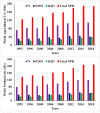Nano-Fertilization as an Emerging Fertilization Technique: Why Can Modern Agriculture Benefit from Its Use?
- PMID: 33375026
- PMCID: PMC7822031
- DOI: 10.3390/plants10010002
Nano-Fertilization as an Emerging Fertilization Technique: Why Can Modern Agriculture Benefit from Its Use?
Abstract
There is a need for a more innovative fertilizer approach that can increase the productivity of agricultural systems and be more environmentally friendly than synthetic fertilizers. In this article, we reviewed the recent development and potential benefits derived from the use of nanofertilizers (NFs) in modern agriculture. NFs have the potential to promote sustainable agriculture and increase overall crop productivity, mainly by increasing the nutrient use efficiency (NUE) of field and greenhouse crops. NFs can release their nutrients at a slow and steady pace, either when applied alone or in combination with synthetic or organic fertilizers. They can release their nutrients in 40-50 days, while synthetic fertilizers do the same in 4-10 days. Moreover, NFs can increase the tolerance of plants against biotic and abiotic stresses. Here, the advantages of NFs over synthetic fertilizers, as well as the different types of macro and micro NFs, are discussed in detail. Furthermore, the application of NFs in smart sustainable agriculture and the role of NFs in the mitigation of biotic and abiotic stress on plants is presented. Though NF applications may have many benefits for sustainable agriculture, there are some concerns related to the release of nanoparticles (NPs) from NFs into the environment, with the subsequent detrimental effects that this could have on both human and animal health. Future research should explore green synthesized and biosynthesized NFs, their safe use, bioavailability, and toxicity concerns.
Keywords: NFs; NPs; biotic and abiotic stress; crop production; plant nutrition; sustainable agriculture.
Conflict of interest statement
The authors declare no conflict of interest.
Figures
References
-
- Dwivedi S., Saquib Q., Al-Khedhairy A.A., Musarrat J. Microbial Inoculants in Sustainable Agricultural Productivity. Springer Science and Business Media LLC; Heidelberg, Germany: 2016. Understanding the role of nanomaterials in agriculture; pp. 271–288.
-
- Food and Agriculture Organization of the United Nations (FAO) FAO Statistics Division. [(accessed on 1 November 2020)]; Available online: http://www.fao.org/faostat/en/#data/QC/visualize.
Publication types
LinkOut - more resources
Full Text Sources




